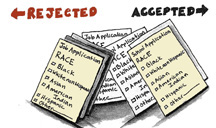Affirmative action
Should colleges give preference to candidates based on race?
If you’re like a lot of teens, you might not be sure what "affirmative action" means. Basically, it gives preference to minority candidates for colleges and jobs based on race. Affirmative action was put in place to help ensure equal opportunity for minorities and women. Throughout its history though, some white college-bound students have felt that minorities were given an unfair advantage in the admission process.
Many students say they would prefer a race-blind policy, where no one would be given preference based on race or ethnicity. The Center for Individual Rights, a conservative group in Washington, has taken up the cause of several white students, who were rejected by the University of Michigan, and decided to sue to change the current policy. This month the Supreme Court started reviewing the case and is expected to make a decision this summer. A case like this has not been heard since the 1978 Bakke decision, which upheld the use of race as a factor in admission decisions, but outlawed quotas (which specify a certain number of a specific group).
Both sides have substantial arguments. Michigan, which is supported by the U.S. military and influential corporations such as Reebok, says diversity will disappear without its affirmative action policy. The plaintiffs suing the school argue that Michigan goes too far by distributing extra points to minorities on their applications. The University of Michigan uses a point system in admissions. They argue that the Bakke decision is out-of-date, and does not permit the university policy, which they say unfairly penalizes some racess. The plantiffs also believe minorities do not need the same help they needed nearly 30 years ago.
However, researchers say that white students who believe they were rejected primarily on ethnicity are going too far, because the number of minorities admitted to Ivy League and other highly selective schools is still relatively small. For example, at the University of Michigan, Ann Arbor (the school the plantiffs were rejected from) American Indians, blacks and Hispanics, combined, make up only 13 percent of the school’s population. The student population is 71 percent white. If only 13 percent of the previously stated minorities make up the undergraduate class, what will happen if affirmative action is outlawed?





